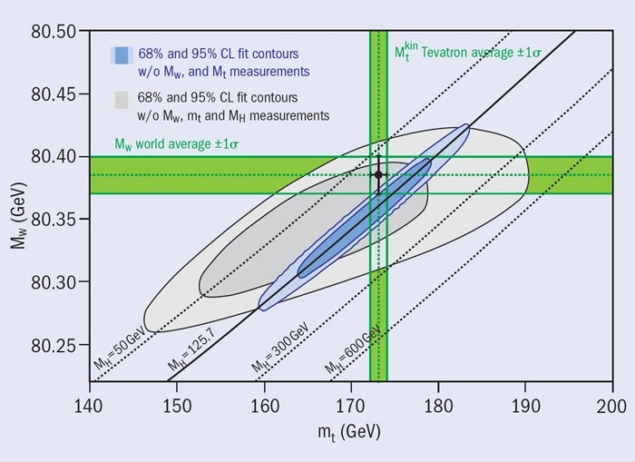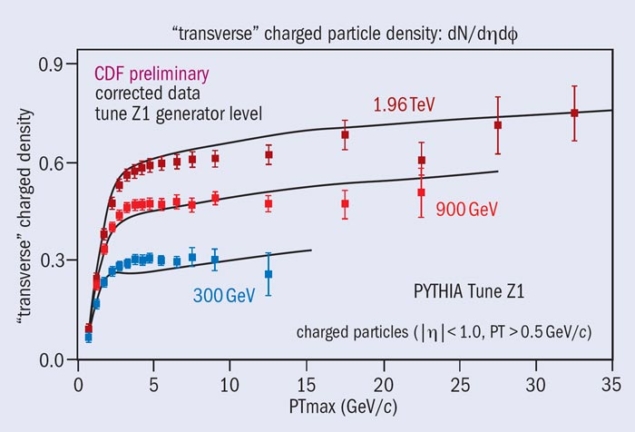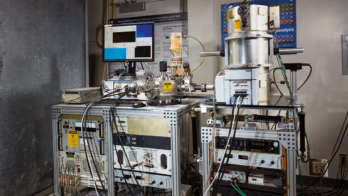Latest results from 10 years of proton–antiproton running.

Image credit: Fermilab.
The first collisions occurred in Fermilab’s Tevatron in 1985. Over the following years, both the energy and the luminosity increased and by the time operations ceased in 2011 the collision luminosity had reached 7 × 1032 cm–2 s–1, more than 350 times the original design value. The Tevatron’s unique feature was its collisions of protons with antiprotons. While it requires substantial technical efforts to make antimatter – the Tevatron’s antiproton source was the world’s most powerful producer of antimatter but still incapable by a long way of the destruction imagined in Angels & Demons – the study of proton–antiproton collisions provides the opportunity to study quark–antiquark interactions against low backgrounds. By the final shutdown, a total luminosity of 12 fb–1 had been delivered to each of the two gigantic Tevatron experiments, CDF and DØ, corresponding to around 5 × 1014 proton–antiproton interactions at a collision energy of 2 TeV.

Image credit: Fermilab.
Images of the two experiments (figure 1) appeared on the front pages of many magazines, in artworks and on TV shows. These modern engineering marvels were largely innovative and demonstrated, for example, the power of a silicon detector in a hadron-collider environment, multi-level triggering, uranium–liquid-argon calorimetry and the ability to identify b quarks. From the collisions provided, the teams recorded the 2 × 1010 most interesting events to tape for detailed examination offline. The analysis effort included searches and studies of new particles, such as the Higgs boson, and precision studies of the parameters of the Standard Model. Many of the exciting results obtained before the end of 2011 have already been summarized in CERN Courier. This article presents an update on some of the results obtained by CDF and DØ over the past two years.
The search for the Higgs boson was among the central physics goals of the programme for Tevatron Run II (2001–2011) and the challenge of understanding the origin of mass in the Standard Model attracted world-leading experimentalists to Fermilab. In 2005, the data sets provided by the Tevatron reached the point where the search for a substantial number of Higgs events above backgrounds could start. From then until 2012, the analysis teams provided not only increasingly stringent direct mass-exclusions but also reduced indirectly the mass range where the Higgs boson could exist, using highly precise measurements of the masses of the top quark and the W boson (see below). By early 2011, results from the Tevatron and CERN’s Large Electron–Positron collider had reduced the allowed mass range to 125±10 GeV, so the joke among experimentalists at the time was: “We know the mass of the Higgs, we just don’t know if it exists.”

The CDF and DØ collaborations developed many new experimental methods in their hunt for the Higgs boson, from the combined searches of hundreds of individual channels for the boson’s production and decay to an extremely precise understanding of the backgrounds and a high-efficiency reconstruction of the Higgs-decay objects. The Tevatron’s high luminosity was the key, because only a few events were expected to remain in the signal region following all of the selections. The unique feature of proton–antiproton collisions was critical for the searches, especially in the decay to a pair of b quarks – the most probable channel for Higgs decay at a mass of 125 GeV. While cross-sections for Higgs production increase with energy and are much higher at the LHC, the increase in the main backgrounds is even faster, so the signal-to-background ratio for this main Higgs-decay channel remains favourable at the Tevatron.
By the early summer of 2012, both CDF and DØ had analysed the full Tevatron data set in all sensitive Higgs-decay modes: bb, WW, ττ, γγ and ZZ. The results included not only larger data sets than before but also substantially improved analysis methods. Multivariate analysis was used to take full advantage of the information available in each event, rather than using the more traditional cuts on kinematical parameters. Such techniques optimize the ratio of signal to background in a multi-dimensional phase space and were critical for reaching sensitivity to the Higgs-boson signal.
What became even more exciting was that in the search channels where the Higgs decays to a pair of b quarks only, the significance of the excess exceeded 3σ
At the Tevatron, the primary search sensitive to Higgs masses below around 135 GeV comes from the associated production of the Higgs boson with W or Z bosons, with the Higgs decaying to a pair of b quarks. This topology increases the signal-to-background ratio, because decays to a pair of b quarks have the highest probability while also minimizing backgrounds as the extra W or Z boson provides useful features, both for triggering and for offline event selection. Nevertheless, reconstructing jets from b quarks – which sometimes consist of hundreds of particles – with high precision is challenging. This is why the expected shape of the Higgs signal is rather wide, with a mass resolution of around 15 GeV, in comparison with searches in the channels where single particles, such as a pair of photons or leptons, are used to reconstruct the mass of the Higgs.
The CDF and DØ collaborations then combined their search results that summer. The excess observed around a mass of 125 GeV, which the experiments had seen for the previous two years, became even more pronounced (figure 2). The significance of the excess was close to 3σ. What became even more exciting was that in the search channels where the Higgs decays to a pair of b quarks only, the significance of the excess exceeded 3σ, indicating evidence for the production and decay of a Higgs boson at 3.1σ (Aaltonen et al. 2012). It was an extremely exciting summer. As the Tevatron passed the baton for Higgs searches (and now studies) to the LHC, its experiments had established evidence of the production and decay of a Higgs boson in the most-probable decay channel to a pair of fermions.

Precise measurements
The Standard Model is one of the most fundamental and accurate theories of nature, so precision measurements of its parameters figure among the major goals and results of the Tevatron’s physics programme. Those perfected over the past two years include the determination of the masses of the top quark and the W boson, both of which are fundamental parameters of the Standard Model.
Since the discovery of the top quark at the Tevatron in 1995, measurements of its mass have improved by more than an order of magnitude. In addition to the larger data sets, from some 10 events in 1995 to many thousands in 2012, the analysis methods have also been improved dramatically. One of the innovations developed for precision determination of the top mass – the matrix-element method – is now used in many other studies in particle physics.
In the channel that allows the most accurate mass measurement, the top quark’s final decay products are: a lepton (electron or muon); missing energy from the escaping neutrino; a pair of light quark jets from the decay of the W boson; and two b-quark jets. Determination of the energy of the jets is the most challenging task for precision measurement. In addition to using complex methods to determine the jet energy based on energy conservation in di-jet and γ+jet events, the fact that a pair of light jets come from the decay of a W boson with extremely well known mass (see below) is critical in obtaining high precision for the top-quark mass.
Using a large fraction of the Tevatron data, CDF and DØ reached a precision in the measurement of the top-quark mass of less than 1 GeV (figure 3), i.e. a relative accuracy of 0.5% (Tevatron Electroweak Working Group 2013). This is based on the combination of results from both experiments in many different channels. All of the results are in good agreement, demonstrating the validity of the methods that were developed and used to measure the top-quark mass at the Tevatron. Analyses of the full Tevatron data set are in progress and these should improve the accuracy by a further 20–30%. Experiment collaborations at both the LHC (ATLAS and CMS) and the Tevatron have formed a group to combine the results of the top-quark mass measurements from all four experiments. Such a combination will have a precision that is substantially better than individual measurements, because many of the uncertainties are not correlated between the experiments.
The measurement of the mass of the W boson requires even higher precision. By the end of the Tevatron’s operation, the combined Tevatron measurement for this particle with a mass of 80 GeV reached 31 MeV, or 0.04%. A precise value of the mass of the W boson is critical for understanding the Standard Model; in addition to being closely related to the masses of the Higgs boson and the top quark, it defines the parameters of many important processes. The main decay channel used to measure the W mass is the decay to a lepton (muon or electron) and a neutrino (“missing energy”). The precision calibration of the lepton energy is obtained from resonances with well known masses, such as the J/ψ or the Z boson, while the measurement of missing energy is calibrated using different methods for cross-checks. The calibration of the lepton energy is the most difficult part of the measurement; larger data sets provide more events and improve the accuracy of the measurement.

Image credit: Gfitter project.
With up to around 50% of the Tevatron data set, the combined analysis of CDF and DØ gives the mass of the W boson to be 80.387 MeV with an accuracy of 16 MeV – twice as good as only a year previously (Tevatron Electroweak Working Group 2013). The accuracy is now driven by systematic uncertainties. In order to reduce them, careful work and analysis of more data are needed; a precision of around 10 MeV should be reachable using the full data set. Such accuracies were once thought to be impossible to achieve in a “dirty” hadron-collider environment.
In the Standard Model, the masses of the Higgs boson, W boson and top quark are closely related and a cross-check of the relationship is one of the model’s most stringent tests. Figure 4 shows recent results for the top-quark mass (from the Tevatron), the W-boson mass (dominated by the Tevatron, with a world-average accuracy of 15 MeV vs 16 MeV Tevatron only) and the mass of the Higgs boson, as measured by the LHC experiments. The good agreement demonstrates the validity of the Standard Model with high precision.
At its inception, researchers had not expected the Tevatron to be the precision b factory that it became. However, with the success of the silicon vertex detectors in identifying the vertexes of the decays of mesons and baryons containing b quarks, the copious production of these b hadrons and the extremely well understood triggers, detectors and advanced analysis techniques, the Tevatron has proved to be extremely productive in this arena. A large number of new mesons and baryons have been discovered there and the properties of particles containing b quarks have been studied with high precision, including the measurement of the oscillation frequency of the Bs mesons.

Studies of particles with b quarks provide an indirect way to look for physics beyond the Standard Model. The rate of the rare decay of the Bs meson to a pair of muons is tiny in the Standard Model but new physics models, including some versions of supersymmetry, predict enhancements. Figure 5 shows how the steady improvements in the Tevatron limits on the decay rate reached around 10–8 by 2012, as more data and more elaborate analysis methods were developed by CDF and DØ.
In late 2011, the ATLAS collaboration presented results indicating the existence of a new particle, which was interpreted as an excited state of a bb pair, χb(3P). It is always important to confirm observations of a new particle with independent measurements and even more important to see such a particle at another accelerator and detector. Within just a couple of months, the DØ collaboration confirmed the observation by ATLAS (Abazov et al. 2012). This was the first time that a discovery at the LHC was confirmed using data already collected at the Tevatron.
Many important studies performed at the Tevatron measure properties of the strong force, which holds together protons and neutrons in the nucleus and is described by the theory of QCD. These include extremely accurate studies of the production of jets and of W and Z bosons accompanied by jets. The Tevatron articles that provide information for the development of the QCD run to tens of pages long and have tens of plots and tables documenting – with extremely high precision – the details of interactions between strongly interacting particles.

One unusual property of the strong interaction is that, contrary to electromagnetic and gravity interactions where the force increases when objects come closer to each other, the interaction of quarks becomes stronger as they move apart. The experiments at the Tevatron studied the strength of the strong force vs the distance between quarks, the running of the strong coupling constant, and verified that the strong force steadily decreases down to a distance between particles of around 5 × 10–16 cm (figure 6).
During the last month of the Tevatron run in September 2011, the CDF and DØ experiments collected data at energies below 2 TeV, going all of the way down to 0.3 TeV in the centre of mass. Such data are useful for studies of the energy dependence of the strong interaction and to compare with previous colliders results, such as the SppS proton–antiproton collider at CERN. An interesting recent measurement is the energy dependence of the “underlying event” in the hard scattering of the proton and antiproton – that is, everything except the two outgoing hard-scattered jets from a pair of hard-scattered quarks (figure 7).
There are many instances when the course of physics changed when experimental results did not fit the current theoretical predictions. Quantum theory and relativity were both born from such “clouds” on the clear horizon of classical physics. Several puzzles remain in the Tevatron data, which are leading to analysis and re-analysis of the full data set. These include the observed anomalous dimuon asymmetry, where the production of negative muon pairs exceeds positive pairs, in contradiction with expectations from the Standard Model (Abazov et al. 2011). This result has attracted much attention, because it could relate to the observed matter–antimatter asymmetry in the universe.

There is also a puzzling effect in the production of the heaviest known elementary particle, the top quark. When top–antitop pairs are produced, more top quarks follow the direction of the colliding proton than is predicted in the Standard Model (Aaltonen et al. 2013, Abazov et al. 2013). Some of the models of new physics predict such abnormal behaviour.
Both of these “clouds” have a significance of 2–3σ and both are easier to study in the collisions of protons and antiprotons at the Tevatron. Will these measurements point to new physics or will the discrepancies be resolved with the further development of analysis tools or more elaborate theoretical descriptions based on the Standard Model? In any scenario, exciting physics from the Tevatron data is set to continue.
The Tevatron was at the leading edge of the energy frontier in particle-physics research for more than a quarter of a century. More than 1000 students received their doctorates based on data analysis in the Tevatron’s physics programme, which as a result trained generations of particle physicists. So far, in excess of 1000 scientific publications have come out of the programme, helping to shape the understanding of the subnuclear world. Analysis of the Tevatron’s unique data set continues and efforts to preserve the data for future access are in progress. There are sure to be many more exciting results in the coming years.





